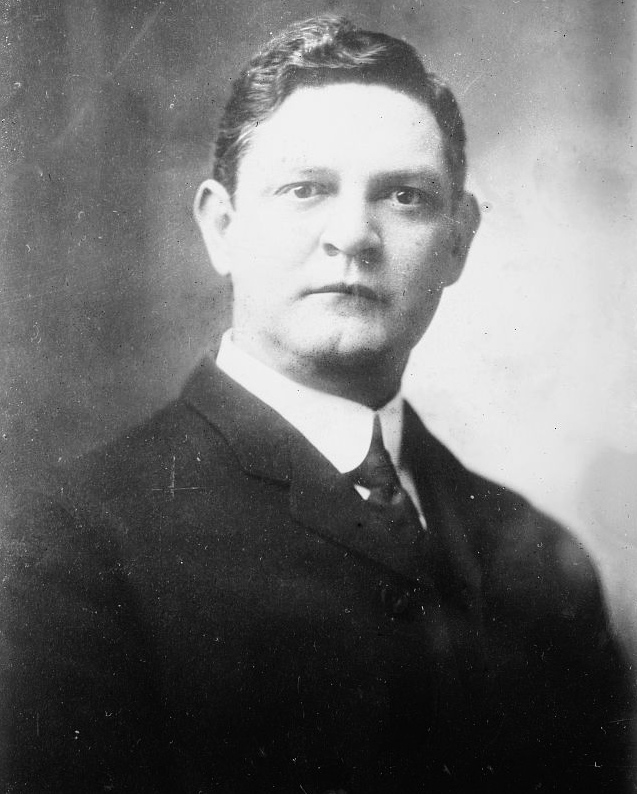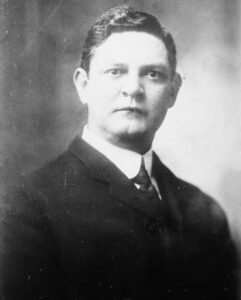Jared Young Sanders
Democrat Jared Sanders, who served as governor of Louisiana from 1908 until 1912, was the first governor elected under a state law that required gubernatorial candidates to participate in a primary election.

Courtesy of Library of Congress Prints and Photographs Division
Jared Young Sanders, Sr. Uncredited photographer for Bain News Service
Democrat Jared Sanders, who served as governor of Louisiana from 1908 until 1912, was the first governor elected under a state law that required gubernatorial candidates to participate in a primary election. A seasoned politician, Sanders readily defeated Democrat Theodore Wilkinson and then Republican candidate Henry Pharr to win the governorship. Sometimes called the “father of the good roads movement” in Louisiana, Sanders is remembered, at least by his fans, for his efforts to improve state infrastructure while protecting its natural resources. Later in his career, he was also an outspoken critic of Huey P. Long.
Jared Sanders, Sr., was born near Morgan City on January 29, 1869, the son of Jared Young Sanders II and Elizabeth Wofford Sanders. (Though he later used Young as his middle name, he was born Jared Morgan Sanders.) He graduated from St. Charles Jesuit College in Grand Coteau and then Tulane University’s law school in 1893. From 1890 to 1893 Sanders also edited and published the St. Mary Banner, a weekly newspaper in Franklin. After graduating from Tulane University, he began practicing law in Franklin at a firm that eventually included his cousin, former governor Murphy J. Foster, Sr. Sanders married Ada Veronica Shaw in 1891, with whom he had one child.
Voters in St. Mary’s Parish elected Sanders to the Louisiana House of Representatives, where he served from 1892 until 1896 and again from 1898 until 1904; he was speaker of the house during his second term. In 1898 Sanders was a delegate to the Louisiana Constitutional Convention. From 1904 to 1908, he served as lieutenant governor during the administration of Newton Blanchard.
As governor Sanders supported progressive legislation but wanted to improve infrastructure without incurring debt. During his term, the legislature passed the State Conservation Commission Act, which levied a tax on corporations using state resources. A moderate conservationist, Sanders advocated the reforestation of lands stripped by the lumber industry. On July 5, 1910, the Louisiana legislature elected Sanders to finish the term of Samuel McEnery in the U. S. Senate; Sanders, however, resigned in order to remain in the governor’s office and support efforts—ultimately unsuccessful—to secure New Orleans as the site for the World’s Panama Exposition.
After leaving office, Sanders resumed his law practice while remaining politically active. His first marriage ended in divorce in 1912 and he remarried Emma Dickinson of New Orleans. He subsequently worked as naval officer at the Port of New Orleans from 1914 to 1916 before moving to Bogalusa. Sanders represented Louisiana’s Sixth Congressional District in the U.S. Congress from 1917 to 1921. As a delegate to the Louisiana Constitutional Convention in 1921, he helped develop a master plan for a state highway system and create the Louisiana Highway Department. Sanders later became that organization’s first attorney.
After serving as a delegate to the Democratic National Convention in 1924, Sanders unsuccessfully ran for the U. S. Senate in 1926. His defeat reflected, at least in part, Huey P. Long’s endorsement of Sanders’s opponent, Ed Broussard. Sanders and Long eventually became bitter enemies, reportedly almost coming to blows in the lobby of New Orleans’s Roosevelt Hotel. Sanders died in Baton Rouge on March 22, 1944, and is interred in Franklin.
Adapted from William D. Pederson’s entry for the Dictionary of Louisiana Biography, a publication of the Louisiana Historical Association in cooperation with the Center for Louisiana Studies at the University of Louisiana, Lafayette.
Sources: Roy R. Glashan, American Governors and Gubernatorial Elections, 1795-1978 (1979); Mary E. Sanders, “The Political Career of Jared Young Sanders, 1892-1912” (M.A. thesis, Louisiana State University, 1955); Miriam G. Reeves, Governors of Louisiana (1980); Robert Sobel and John Raimo, Biographical Directory of the Governors of the U.S. (1978).
